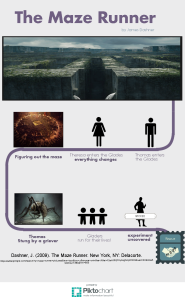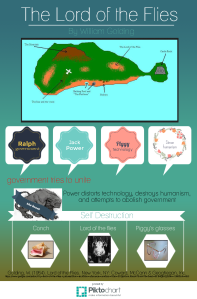Where do opportunities for differentiation exist within the LOTF and MazeRunner Scenarios?
There are lots of opportunities for differentiation within both the LOTF and the MazeRunner scenarios.
The Lord of the Flies:
- In scenario one, students are given the opportunity to create. This leaves the door wide open for very differing opinions. Students are able to create a world that they believe would have existed before the plane crash. They could even have the comfort of building in groups or on their own.
- Scenario two is also open to creativity. It allows for the students to come up with their own government, rules/laws, and codependence or independence. They get to make the decisions and if they have a tough time with that they have their classmates to lean on for guidance. In survival mode it turns it up a notch and starts to challenge all students. Those who have a difficult time surviving are able to respawn.
- Scenario Three is back to creative mode. Symbolism opens the door to your imagination again. The book had many symbols, now the group gets to come up with their own created ones. This also challenges students to make connections with their community and a symbol, which can be very difficult. Working in a group again allows for guidance from others. Those who would rather work alone can talk with the group then do tasks on their own that will help represent the symbol they have chosen.
The Maze Runner:
- Scenario one allows for those creative juices to flow. Students are able to create a maze of their choosing. Being in creative mode they are able to place what they feel is necessary in chests to help others survive while traveling through their maze. This too allows for independent and group work.
- Scenario two, which is also in creative mode allows you time to create the “Glades” for your maze. Using what they have read students can expand on what they pictured the community inside of the maze looked like. There are jobs for everyone to do, splitting up the tasks according to what the students want to focus on. Another group effort that can be worked on together or individually after discussion.
- Scenario three is the actual game. Students are in survival mode with a purpose of surviving and exiting the maze. They can choose to go it alone or work as a team and have a higher chance of survival.
The differentiation is in all of the scenarios since they are laid out as both group activities and possibly individual tasks. It leaves a lot open for the students to be challenged, have to support their creations with the text, and be able to modify things to suit their own personal needs and abilities. These are going to be a lot of fun for the kids!
The LOTF infographic shows the island and where things happened on the island. Then it focuses on the four main characters; Ralph, Jack, Piggy, and Simon and show what they represent (government, power, technology, and humanism respectively). Ralph tries to lead them by uniting them all, but because of the scare of the beast Jack is able to twist things to his whim. In the end, they were their own self-destruction. I also have three symbols represented in the book (conch, pig head on a stake, and the Piggy’s broken glasses). The references are the book and a site where I found all of the pictures.
The Maze Runner infographic has a picture of the maze, then a quick time line. The arrival of Thomas, then Theresa with changes, maze running, Thomas getting stung, Gladers running the maze to escape, discovery of the experiment (WICKED) and their rescue by possible WICKED employees. References for this one were also the book and a site where I obtained all of the pictures.
My plan is to create badges for these two games. I plan to work on a ways to make it easier for teachers to utilize them.


The badges sound like a good idea. What will they get the badges for? Please post a write up about your tool and any links or videos on the diffi mooc Google community.
LikeLike
I plan to do a write up with links. When is the next scenario starting? I want to get it all out to them prior to the start of the next scenario.
LikeLike
I agree that there is a lot of differentiation n all scenarios. They can work together or even by themselves. I am very impressed with your infographics as well. I didn’t know that you can get images like that. I still have much to learn about using inforgraphics.
LikeLike
It took quite a bit of time to get those infographics together. I am just learning about it as well. I like to screen shot pictures and paste them into paint. Then I crop it and save it as a picture. I can then upload it onto the infographic site. That’s how I do the badges as well.
LikeLike
There are a lot of opportunities to differentiate within each of the scenarios for each book. I like how you mentioned the fact that they could lend to supporting their work with text from the book. Maybe more kids will have read the books this time, that really surprised me that they weren’t required to do so before participating in Givercraft, seemed like it would be a necessary component. Good ideas and infographics!
LikeLike
I totally agree. I would have required them to read the book first as well. I think it is important that they be able to support their work with text from the book that the scenario is based around.
LikeLike
As I’ll also be making some badges, I would like to know how yours will be awarded. What will they have to do? What evidence will they need to show?
I’m hoping that the abundance of badges will not result in badge inflation. When there are too many badges on the market, the value (meaning) of having a badge will decrease. It’s kind of like those awards ceremonies when every kid in the school get an award. They know that nobody will be left out, so having an award doesn’t mean much.
LikeLike